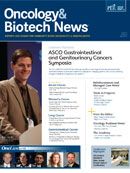More Research Needed to Define Appropriate Targets for Biologic Therapy of Gastric Cancer
More research is needed to define molecular subtypes of gastric cancer and identify appropriate targets for clinical use.
Photo by © ASCO/Todd Buchanan 2012
Manish A. Shah, MD
Intelligent use of targeted therapies in gastric cancer is an important goal but is thus far elusive. More research is needed to define molecular subtypes of gastric cancer and identify appropriate targets for clinical use.
Speaking at the ASCO 2012 Gastrointestinal Cancers Symposium on the future of targeted therapies in gastric cancer, Manish A. Shah, MD, director of Gastrointestinal Oncology at Weill Cornell Medical College/New York Presbyterian Hospital, New York City, explained that it has been known for more than 40 years that there are distinct subtypes of gastric cancer, yet clinical trials have grouped gastric cancer patients together.
“It may have been appropriate to group all gastric cancer patients together when cytotoxic therapeutics like 5-FU were being studied. But when we talk about targeted therapies for gastric cancer, the subtypes matter, and they will matter more as we design trials for targeted therapies for this disease,” he stated.
Gastric cancer is not one disease, he continued. This is supported by epidemiology and risk factors, response to therapy, and genetic analysis.
Epidemiologic studies have shown that gastric cancer in Asian countries is different from gastric cancer in the United States in terms of location of tumor, stage at diagnosis, postoperative mortality, response to therapy, and outcomes.
One study that Shah discussed compared gastric cancer in Koreans and Americans treated at two institutions, one in each country. More tumors were found in the middle and lower stomach in Koreans, while more tumors in the gastroesophageal and upper gastrointestinal tract were found in Americans. Cancer was generally diagnosed at an earlier stage in Koreans, while the diagnosis was evenly split among four stages in Americans. Postoperative mortality was .2% in Koreans and 2% in Americans. Five-year disease-specific survival was 82% in Koreans and 74% in Americans.
“After adjusting for all known risk factors, disease-specific survival for Korean gastric cancer patients is significantly higher than in the US by about 20% to 30%. The study does not exclude inherent biological differences. This suggests a different biology [in Asians and Americans],” Shah stated.
“
When we talk about targeted therapies for gastric cancer, the subtypes matter, and they will matter more as we design trials for targeted therapies for this disease. ”
—Manish A. Shah, MD
Shah said that gastric cancer can be classified into three different subtypes: proximal nondiffuse type 1 tumors, diffuse type 2 tumors, and distal non-diffuse type 3 tumors. These three tumor subtypes have different histological patterns, and more recently, it has been shown that they have three different genetic patterns.
A 2011 study by Wang et al in Nature Genetics analyzed 22 matched pairs of gastric cancer specimens and normal tissue. The authors showed that these tumors are genetically diverse; 59% of gastric cancer samples had an error in chromatin modification; 59% had an error in cell junction organization; and 77% had an error in cell cycle organization.
A second group of investigators (Tan et al, Gastroenterology 2011) identified a 171-gene signature that can robustly classify tumors to predominantly intestinal and predominantly diffuse gastric cancer subtypes. “These authors were setting up a dichotomy,” Shah explained.
The implication of genomic analyses is that gastric cancer is not one disease. Several subtypes exist, and that may explain the observed differences in response and prognosis.
“If you accept that gastric cancer is not one disease, the subtypes may have different molecular drivers and different therapeutic targets. This is the future of targeted therapies in gastric cancer,” Shah said.
Table. PFS by Gastric Cancer Subtype
Cancer Subtype
Response Rate (%)
Median PFS, mo
Proximal / GEJ
17/20 (85)
16.3 (8.9-NR)
Distal / Intestinal
5/9 (56)
14.3 (1.8-19.9)
Diffuse
3/8 (38)
8.6 (3.1-12.0)
GEJ indicates gastroesophageal junction; NR, not reported; PFS, progression-free survival.
Adapted from Shah MA, et al. J Clin Oncol. 2011; 29(7):868-874.
A small phase II study of 44 patients with gastric cancer treated with antiangiogenic therapy at Memorial Sloan-Kettering Cancer Center showed that 6-month progressionfree survival (PFS) was different for the three subtypes of gastric cancer that Shah outlined. Proximal cancers had the best PFS, distal tumors had intermediate PFS, and diffuse gastric cancers had the poorest PFS (Table). This study illustrates the importance of subdividing gastric cancers prospectively for clinical trials to move the field of targeted therapy along.
“The solution is to understand the target and understand the disease. The future looks bright,” said Shah.




